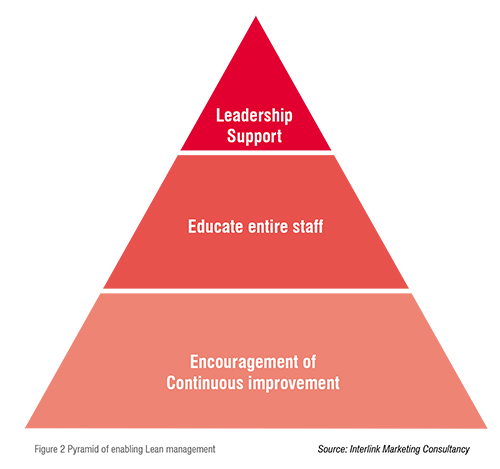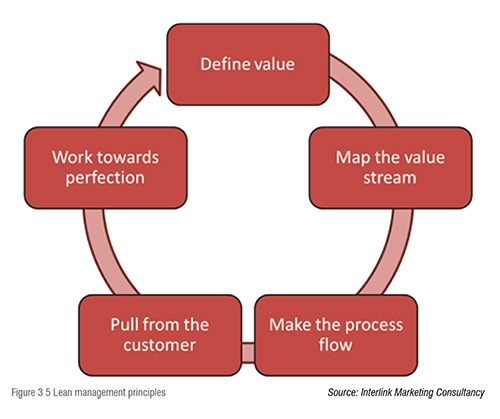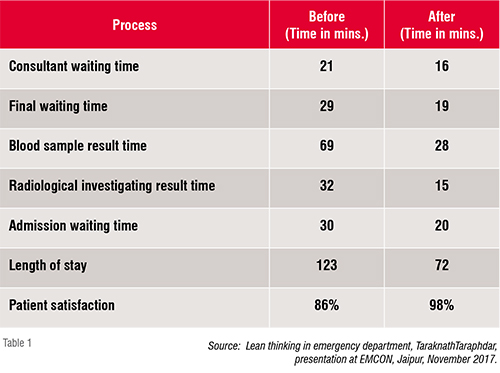Lean management could prove to be an essential tool for solving a key issue of the emergency department: overcrowding. Lean management works towards reducing the non-required items/ processes/ activities commonly known as ‘waste’ and streamlining the system towards qualitative services. Applying lean management would result in sustainable growth due to realignment of services and processes towards patients and staffs satisfaction. It further reduces unnecessary cost burdens on patients, staff, and the environment while also facilitating continuous improvement for innovative services leading to patient benefits and profitability.
Globally, healthcare systems are under pressure to improve quality and patient outcomes using evidence-based interventions. Many healthcare organisations are turning to industrial improvement approaches, such as the lean management system, 5-S model, Six sigma, etc., to enhance quality and safety. The critical part of emergency department is the 24* 7 working hours during which it is almost always overcrowded. Thus, minimising the non-relevant and non-required items/ activities from the system and reducing waste would prove to be beneficial, and this is what lean management aims towards.
Lean thinking is a visual state of mind, whereby the focus is on the task and nothing else is encouraged. Lean management in healthcare systems was first applied way back in 2004 at the Mason Hospital, Virginia,USA, to improve their process methodology. A study also reveals that some hospitals in USA in 2009 implemented lean system to improve the quality of healthcare services, out of which 60 per cent applied in emergency department.
The emergency department is characterised as a critical department in hospital setting and is occupied by varied patient types. Various countries have applied National Emergency Department Inventories (NEDI) survey as a standardised method to benchmark the characteristics of emergency department.
Overcrowding in emergency departments is a global problem and has been recognised as a national crisis in some countries as it hampers the objective of service to the patient. The improvement, in terms of cost of care, the quickness of service, handling of crowds, swiftness in triage process, and most importantly, patient safety are now widely accepted by means of patient-centricity. The workflow of the emergency department should be planned in such a way that the staff could attend immediately to unscheduled and unexpected patient inflow.
One survey showed that a varied number of emergency departments has high annual visit volumes and long length-of-stay, and most of them are over loaded.
There is no doubt that the emergency department is the most complex clinical department in modern hospital infrastructure. It is always intended to have well designed infrastructure and depending on the condition of the patient and whether the patient is with occupier or not priority of formalities and treatment needs to be decided. Nothing is more crucial than saving lives!
Many a times, disparity between capacities of the emergency department, requirement of triage process, diagnostic tests and consultation with doctor affects the patient flow to a greater extent in. In addition, some studies have recognised overcrowding as the major reason for adverse patient outcome, delayed treatment, prolonged length of stay and hospital readmission.
Well, to solve those issues revisiting the workflow of the entire process of the emergency department isa prerequisite and needs to be integrated along with collaborative support from all healthcare professionals involved in the emergency department.
Not only does lean management reorganise services and systems for patients, it also indirectly affects employees. Streamlining the work processes directly affects the staff and helps them in managing their work pressure accordingly. Lean is implemented in particular contexts and success is dependent on how it fits into the system.
Let's look at the principles of lean management that help understand the basic concept of lean.

Define value
The first stage is to define the value of your products and services as per customer requirements which is directly proportional to beneficiary in terms of footfalls. It is supreme to determine the actual or latent needs of the customer. To better understand the Lean management principles we should start with defining “customer value”. Value is what the customer is keen to pay for. Sometimes customers may also be unable to express it. This is particularly observed when it comes to novel products or technologies. Applying to recent trends, Artificial Intelligence (AI) and machine learning are some that need to be perceived by patients. There are various ways like focus group interviews, surveys, footfall analysis, demographic information and web analytics that can lead you to know your customers preferences.
Map the value stream
In this step, the objective is to use the customer’s value as a reference point and to identify all the other factors those contribute to these values. Those activities that do not add value to the patient are considered waste and should be eliminated. The waste can be differentiated into two categories: non-value added but necessary and non-value but unnecessary. The latter is pure waste and should be eliminated while the former should be reduced as much as possible depending on the patient preferences and reducing the cost of production of that particular product or service.

Make the process flow
Once elimination of non-value added services or products is done, ensure that the rest of the process is smooth. Strategies to ensure that process runs smoothly, measures that can be taken include breaking down the major stages into two three subsequent steps, levelling out the workload amongst the staff, creating cross-functional departments, and training employees to be multi-skilled, talented and adaptive to environmental changes.

Pull from the customer
The aim of applying a pull-based system is to limit the inventory to required things and work in progress. Also, assurance of the availability of required materials and data at appropriate time for a seamless process of work is necessary, as it enforces ‘In-time’ delivery. Pull-based systems are always prioritised based on the needs of the end customers.
Work towards perfection
Once the process is set in order by implementing the first four steps, the fifth step of chasing perfection is of utmost importance. It makes lean management thinking an integral part of the organisation and lends a continuous process of upgrading accuracy and precision in organisational culture. Every employee should endeavour to exactness while providing service to the patient. One should always remember there is no limitation to learning, and it is a steady process.
The 5 Lean management principles create a background for wellorganised and active organisation. It allows managers to reduce inefficiencies, deliver better value to customers, create efficient workflow, and develop a continuous improvement culture. This will encourage competitive environment, increased value, decreased cost to run business, and indirectly increase profitability.
Implementing lean in the emergency department should start with cleaning up cluttered spaces by removing or replacing unnecessary items. This would free-up the space across the overcrowded department and facilitate smooth movement.
A small study conducted in a hospital showed that the average length of stay is approximately 1 hour and 41 minutes. Various factors govern the length of stay starting from the time required for the registration process, time invested by patient’s kin in taking decisions, making financial arrangements, and to submit documents. Furthermore time taken by consultant to attend the patient, even the waiting time for radiology investigations or other laboratory reports are time consuming and stressful.

Following is the observation of time required for various processes (in minutes) from experience of lean in Emergency department: [1]
The main issue and concern for any emergency department is overcrowding. Hospital managers need to examine their operational procedures to resolve this concern. Once the reason for overcrowding is known, then tackling it won’t take much time. The standard time an individual spends in emergency department is 5-6 hours. The care provided to in-patient and emergency department should be the same and the processes should ensure safe and qualitative care.

The staff plays a major role in the up-gradation of the organisation. Taking into account the operational realities, techniques, and relatively inflexible culture make it challenging to implement lean management. Many a times hospitals are not aware of the lack of resources or training of soft skills which may reduce time required for interaction. The in-patient department is often trained for usage of new devices, but the emergency department tends to get overlooked as a different entity, although the emergency department staff may benefit from it. Empowering the staff with proper training and resources can eventually contribute to other efforts such as improved services and reduced waiting times.
Although many hospitals share common problems such as overcrowding, it is important to remember that each hospital has its own environmental issues depending upon the culture. Morality of employee may seem to be a minor issue, but if staff is unhappy then this could hamper services and may escalate to staff inefficiencies that could badly affect the image the of hospital. In this case, the management leadership should be firm enough to take decisions toward establishing processes and improving inefficient practices.
Lean management through the use of the following initiatives can prove to be an effective way forward:
1. Replacing traditional nurse-based triage with a team of triage including physicians has proved to be beneficial as it could discharge more patients that too without admission.
2. Depending on the patient flow, high/low flow strategies can be implemented when there is overcrowding and some of them may get treated in initial care unit.
3. Another way to tackle overcrowding is to employ a waiting room that allows treatment by the time primary diagnostic tests results are revealed.
A continuous improvement mindset is essential to reach the company's goals. The term ‘continuous improvement’ means incremental improvement of products, processes, or services over time, with the goal of reducing waste to improve workplace functionality, customer service, or product performance. Lean is founded on the concept of continuous and incremental improvements on product and processes while eliminating redundant activities. "The value of adding activities are simply only those things the customer is willing to pay for, everything else is termed as waste, and should be eliminated, simplified, reduced, or integrated".
References:
1. Lean thinking in emergency department, Taraknath Taraphdar, presentation at EMCON, Jaipur, November 2017.
2. Overcrowding in emergency departments: A review of strategies to decrease future challenges, Mohammad H Yarmohammadian, Fatemeh Rezaei, Abbas Haghshenas, and Nahid Tavakoli;J Res Med Sci. 2017.